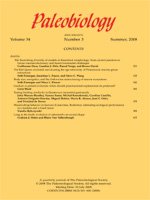The species-characteristic combination of morphological characters that depend on an environmental gradient can be used to determine the frequency distribution of the species along the gradient. All functional characters of a phylogenetically closely related species group demonstrate overlapping intervals along an environmental gradient. The gradual change in character composition along the gradient is called a morphocoenocline. Based on transfer functions, a morphocoenocline can be used for gradient values estimation (proxies) in the historical or geological past, similar to a coenocline based on species (democoenocline).
Transforming the empirical frequency distributions of characters and character states along the gradient to probability distributions enables calculating a probability density function of any subset of characters of the morphocoenocline. Because a species is distinguished by a specific combination of characters that are functionally related to the gradient, the distribution of this species along the gradient can be estimated using the probability density functions of combined characters. Assuming “functional uniformitarianism” this estimation can be extended into the geologic past for all fossil species, as long as their functional characters are homologous or analogous to those found among Recent forms. When a morphocoenocline is based on a compound environmental gradient, such as depth, which represents a combination of single environmental factors, the gradient estimation reflects only a specific combination of single factors.
A morphocoenocline for test characters of symbiont-bearing benthic foraminifera from the West Pacific was established for water depth. This compound environmental gradient represents tropical open sea conditions at a slope where the water is highly transparent (low inorganic nutrients and sediment input). Depth distributions based on probability density functions were compared with empirical distributions to prove the accuracy of this method, and were used to estimate the depth distribution of other living species that had not been included in the determination of the morphocoenocline because they live in other regions. The method was also applied to fossil species that are closely related to Recent forms (Nummulites, Assilina from the Eocene) and to fossil species that are more distantly related to the living species (Orbitoides from the Upper Cretaceous).





